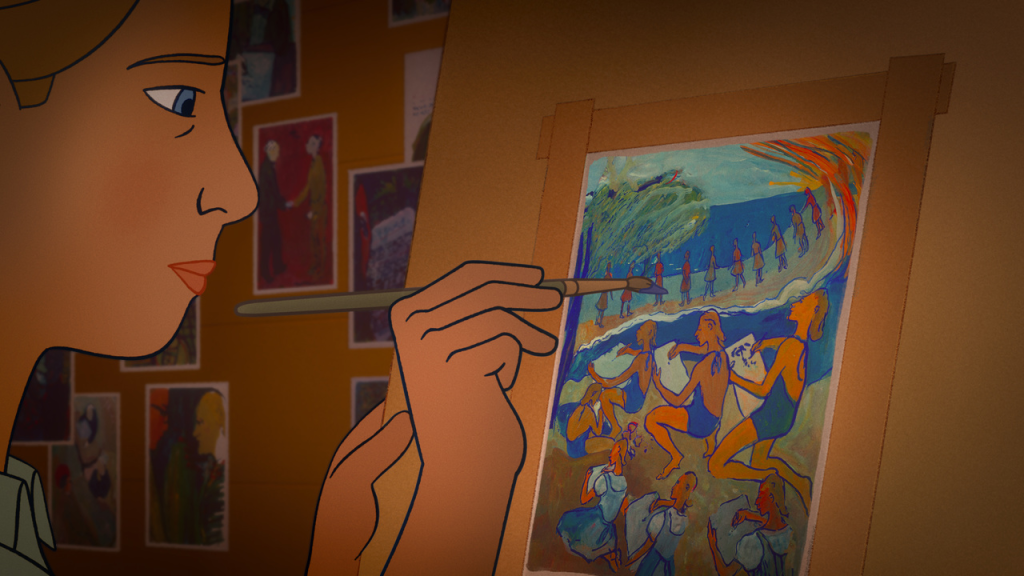Few victims of the Holocaust left behind such a methodical and memorable record of their life as Charlotte Salomon, a native Berliner who died in Auschwitz at age 26. As if anticipating that premature end, she’d spent much of the preceding two years painting about a thousand gouaches composing the illustrated autobiography “Life? Or Theater?,” which fortunately survived the war. Now permanently exhibited at a museum in Amsterdam, they’ve generated a number of works in other media, including an opera, stage plays, a ballet, a novel, a 1981 Dutch dramatic feature, and several documentaries.
“Charlotte” is likely to introduce Salomon’s story to a larger audience by virtue of its appeal to animation fans, plus the lure of a starry voice cast led by Keira Knightley. (Marion Cotillard performs the title role in a forthcoming French-language version.) Audiences who responded to recent awards magnet “Flee’s” style of hard-hitting, fact-based narrative in cartoon form will find some similar rewards in this collaboration between directors Eric Warin (“Leap!”) and Tahir Rana (“Angry Birds: Summer Madness”).
What might have seemed a familiar if sad drama in live-action form benefits from this relative novelty of presentation, which lends a certain universality, as well as heightened viewer access, to Salomon’s story. But the rather pedestrian animation here also makes “Charlotte” a bit of a disappointment: The film seems to take little inspiration from its subject’s much bolder, more distinctive visual style. Good Deed Entertainment begins opening the multinational coproduction on U.S. and Canadian screens from April 22.
The narrative is framed by Knightley’s Charlotte entrusting a suitcase of her paintings to friend Dr. Moridis (Henry Czerny, who voices several small roles), knowing that they are no longer safe in her possession. Erik Rutherford and David Bezmozgis’ screenplay then rewinds eight years to 1935, when the teenaged Charlotte is attending a concert with her parents that gets invaded by Nazi thugs yelling, “Jews out!” They are horrified, but not particularly surprised; our heroine had already dropped out of school some years earlier, in protest at the pervasive embrace of Hitler and anti-Semitism. With her father (Eddie Marsan) a surgeon, the family could afford to continue her education at home.
As an aspiring artist, she is soon thrilled to gain acceptance to the local art academy, though their gesture of tolerance towards a Jewish applicant is already a risky move unlikely to last long. Meanwhile, she fixates romantically on the voice teacher (Mark Strong) tutoring her classical singer stepmother (Helen McCrory), though that stolen May/December affair is likewise short-lived.
As things get steadily worse for Jews in Germany, Father is arrested and sent to a camp for a couple of months, returning in threadbare health. With exit visas now scarce, her parents insist Charlotte leave for the South of France, under the pretense that her grandparents are old and frail enough to require her help. But the political climate has only aggravated Grosspapa (Jim Broadbent), who often directs his stuffy, obstinate ill-temper at his granddaughter, while Grossmama (Brenda Blethyn) has retreated into deep depression. A bright spot is their welcome into the fold of rich American Ottile Moore (Sophie Okonedo), whose country estate here provides harbor for various refugees, and patronage for Charlotte’s art. It also supplies another stray, Alexander Nagler (Sam Claflin), with whom Charlotte falls in love. But by mid-1943, no refuge in Vichy France is safe enough for two foreign Jews.
“Charlotte” unfolds in straightforward, engaging fashion, its partly-conjectured biography (“Life? Or Theater?” discreetly left some matters to the imagination) advancing via to-the-point scenes and dialogue — Salomon was not, by all accounts, much of a talker. Inevitably, there’s a terrible sense of needless loss, the terror of Nazi persecution exacerbated by our heroine’s realization that mental illness and suicide have run through her family bloodline.
Love Film & TV?
Get your daily dose of everything happening in music, film and TV in Australia and abroad.
Yet moving as this story can hardly help but be, the film seldom seems as inspired as one might hope for, given the source material. Salomon’s paintings (a minority of which were first published in 1963 book “Charlotte: A Diary in Pictures,” utilizing her own explanatory texts) are Expressionist images of seemingly unsophisticated craft but great power in color, emotion and unusual composition, often depicting multiple events or locations in a single frame. They’re vivid and inventive in ways that the competent but rather blandly characterless line animation and pretty backgrounds here are not. Particularly given that some of the film’s producers were also involved in “Loving Vincent,” which so meticulously translated Van Gogh’s aesthetic, “Charlotte’s” visual orthodoxy is a letdown.
Furthermore, Knightley’s chirpy tone and bright, clipped diction make Charlotte sympathetic, but don’t lend a lot of weight to a young woman whose strong will and despairing moods occasionally stirred family conflict in real life. Ideally, there might also have been a more nuanced soundtrack component than Michelino Bisceglia’s big, conventional orchestral score.
Nonetheless, this remains a remarkable story, even if told in a less-than-remarkable film. There were some shocking turns in Charlotte Salomon’s life even before she got shipped to Auschwitz and immediately killed there, while five months pregnant. No doubt there will continue to be dramatizations of her tale, some perhaps better than “Charlotte.” But for many this will comprise an introduction, and it’s just strong enough to serve as an honorable one.
From Variety US































